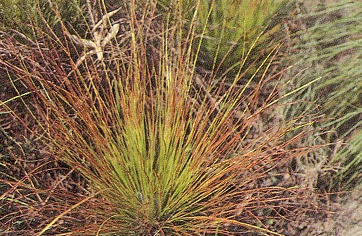
by Michael Goodchild | May 22, 2016
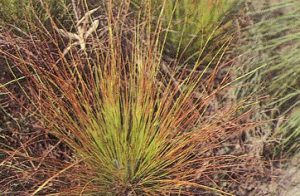
Controlling competing vegetation and brown spot disease are two main reasons we prescribe burn young longleaf plantations:
- Longleaf pine seedlings do not like competing vegetation and will stay in the grass stage for years if vegetation is not controlled by fire, mowing or herbicides. Using improved containerized seedlings along with good vegetation management can release longleaf pines from the grass stage in 2-3 years.
- Longleaf pines are the only species of southern pines susceptible to brown spot needle blight. Seedlings are infected in the grass stage and can die from the disease. Prescribe burning is an effective method for controlling this fungus disease. Burning removes the infected needles and kills the spores. Brown spot can be identified by yellow bands on the needles, which eventually turn brown as shown below.
December thru March is the typical burn window for this activity. Older longleaf pine stands can be burned into late spring with the right weather conditions and understory. If turkey management is important to you, wait until nesting season is over to burn mature longleaf stands. We get better control of understory brush and hardwoods burning in the spring.
The link shown here shows an example of a control burn in 5 year old longleaf pine that is in the sampling stage. Good forest management practices have got these pines off to a good start. The key is not to damage the bud in the tip of pines or the newly formed candles in the spring.
*Make sure and get a burn permit from the local state forestry service before you light your fire.
References:
“Timing of Prescribed Fire in Longleaf Pine” http://www.southernfireexchange.org/SFE_Publications/etc/Clemsonforfl32.pdf
“Prescribed Burning in Newly Planted Longleaf Pine.” (Alabama Guide Sheet No. AL 338 A)
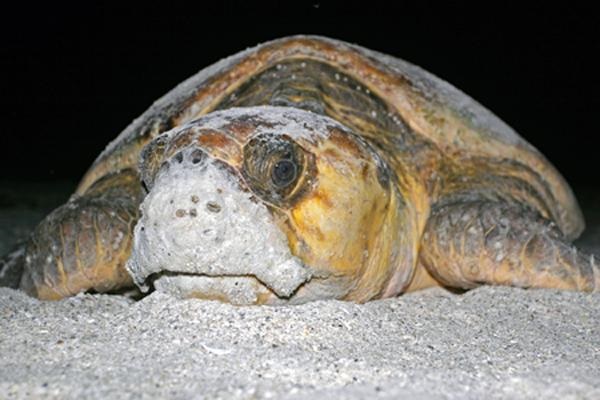
by Erik Lovestrand | May 22, 2016
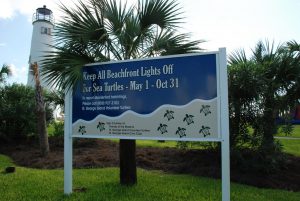
Awareness is Growing!
Photo by: Aprile Clark
That is, when it comes to lights on our homes and businesses near their nesting beaches. Humans have long-known that artificial light can have negative consequences for many nocturnal animals, including nesting and hatching sea turtles. However, it has only been through fairly recent research that we are beginning to understand the reasons behind some of these effects and developing better lighting (or non-lighting) strategies and alternatives to protect our treasured marine turtle species.
Mother sea turtles that nest on Florida Panhandle beaches are “hard-wired” for nighttime activity when it comes to digging their nest cavities and depositing eggs. Likewise, their babies typically leave their sandy nests under cover of darkness, scampering to the Gulf of Mexico. This nocturnal behavior is important for avoiding predators that would have an easy meal of a baby turtle crossing the open beach in the light of day. However, even hatchlings emerging at night face a number of other obstacles. Once in the water there are a many aquatic predators that will not hesitate to gobble up a baby turtle. On average, it is estimated that only about 1 in 1000 babies survive to reach adulthood. With those odds, it would be wise for us to do anything we can to minimize additional threats or hazards during the short but crucial time these marine reptiles spend on the narrow thread of beachfront that we share with them.
One thing we can do involves reducing the disorienting effects of artificial light near our sea turtle nesting beaches. The term “phototactic” is used to describe organisms that are stimulated to move towards or away from light. Nesting females have been shown to avoid bright areas on the beach but hatchlings tend to be attracted to the brightest source of light when they emerge from the sand. On a nesting beach with no artificial lighting, any natural light from the moon or stars is reflected off the water, creating a much brighter horizon in that direction. This naturally attracts the hatchlings in the right direction. Lights from human sources can appear very bright in comparison and quite often draw babies over the dunes and into harm’s way on roadways, from predators, or simply by exposure once the sun comes up.
Many beachfront property owners have learned about this threat and have taken this issue to heart by reducing the amount of light on their property and eliminating or replacing lights visible from the nesting beach with sea turtle-friendly lighting. There are three rules to follow when retrofitting or installing new lighting near the beach.
- Keep it Long: Long-wave-length lighting that is still in the portion of the spectrum visible to humans includes amber, orange and red light. Manufacturers are now making highly efficient LED bulbs that are certified by the FWC as turtle-friendly.
- Keep it Low: Many times lighting needed for safety of access can be placed low enough to be unseen from the nesting beach.
- Keep it Shielded: Fixtures that are in line-of-site to the nesting beach need to be recessed to shield the bulb from being directly visible. The correct long-wave-length bulb should also be used in these shielded fixtures.
Remember, exterior lighting is not the only danger turtles face from our lights. Unobstructed interior lights seen through windows and doors can be just as detrimental. The best solution here is to tint beach-facing glass with a 15% transmittance tinting product. This will save money on cooling bills as well as protect interior furnishings and avoid the possibility that someone in your house might leave the blinds or curtains open accidentally during turtle season. If you have questions regarding turtle-safe lighting practices in Florida there are many resources available through the Fish and Wildlife Conservation Commission the National Marine Fisheries Service, the Sea Turtle Conservancy, and your local UF/IFAS County Extension offices. If you really want to get into the nitty-gritty of turtle lighting and ways to protect turtles check out this FWC publication on assessing and resolving light pollution problems and this model lighting ordinance from UF’s Levin College of Law. Most Florida coastal counties have already adopted sea turtle lighting ordinances so you should also check your local county codes for this issue. Let’s help keep sea turtles in the dark, where they need to be.
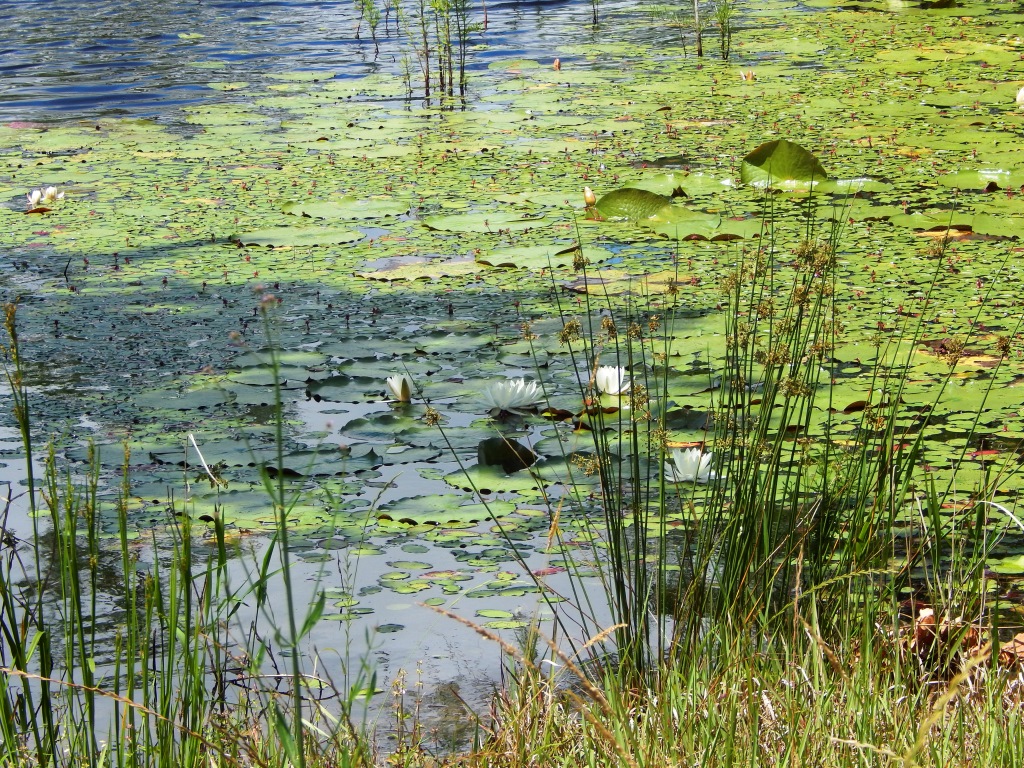
by Mark Mauldin | May 22, 2016
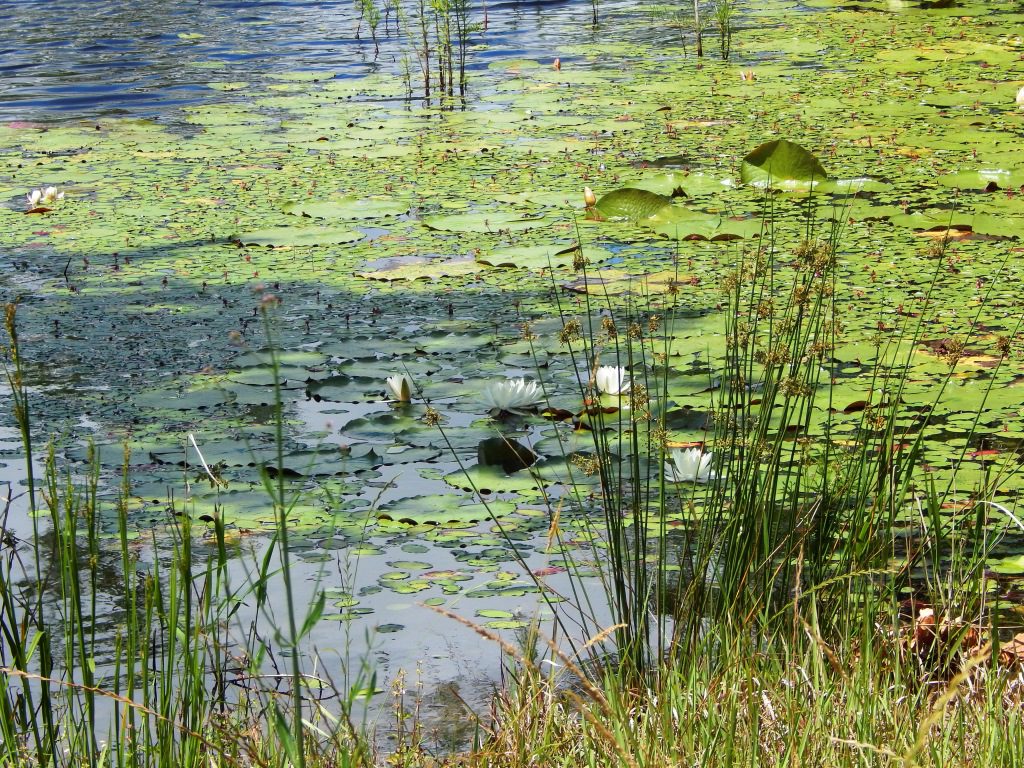
Managing a pond can be both rewarding and challenging.
Photo Credit: Mark Mauldin
Ponds can be a source of great enjoyment. However, properly managing them to meet your desired goals can be challenging. Panhandle Pond Management, a two part series being offered by UF/IFAS Extension, is designed to help pond owners/managers become more successful in reaching their goals. Specialists from campus will be onsite to share their expertise. Dr. Chuck Cichra, UF Fisheries and Aquatic Sciences, will lead session 1 and Dr. Stephen Enloe, UF Center for Aquatic and Invasive Plants, will lead session 2.
Session 1 – May 31st Fish Management will focus on decisions that the pond owner can make that directly relate to the success and productivity of the fish population in a pond. Stocking, harvesting, feeding, aeration and other topics will be covered.
Session 2 – June 7th Aquatic Weed Management will involve weed identification, control options, and herbicide application techniques. If you have problem weeds bring samples for identification and control recommendations.
Panhandle Pond Management will be held at the Washington County Agricultural Center, 1424 Jackson Ave, Chipley FL. Each session will begin at 6:00pm; a meal will be served. To ensure we have enough food advanced registration is strongly encouraged. There is a $10 registration fee per session. To register call the Washington County Extension Office (850-638-6180) or use the links below for online registration. Session 2 attendees will receive a copy of Weed Control in Ponds a bound book sold through the IFAS bookstore.
Online Registration
Session 1 – https://goo.gl/Rwn9dk
Session 2 – https://goo.gl/zj58o6
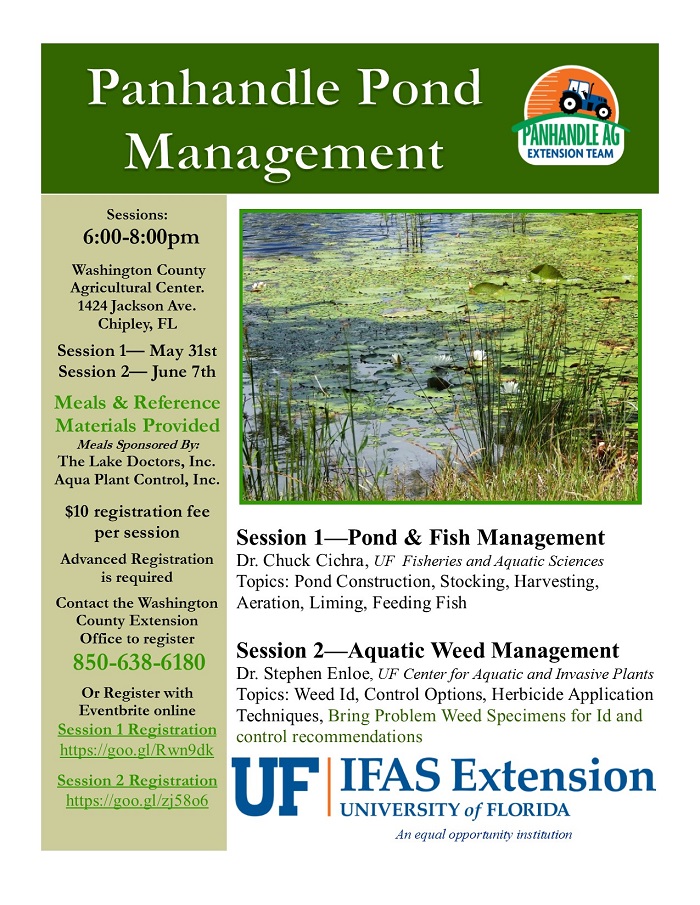
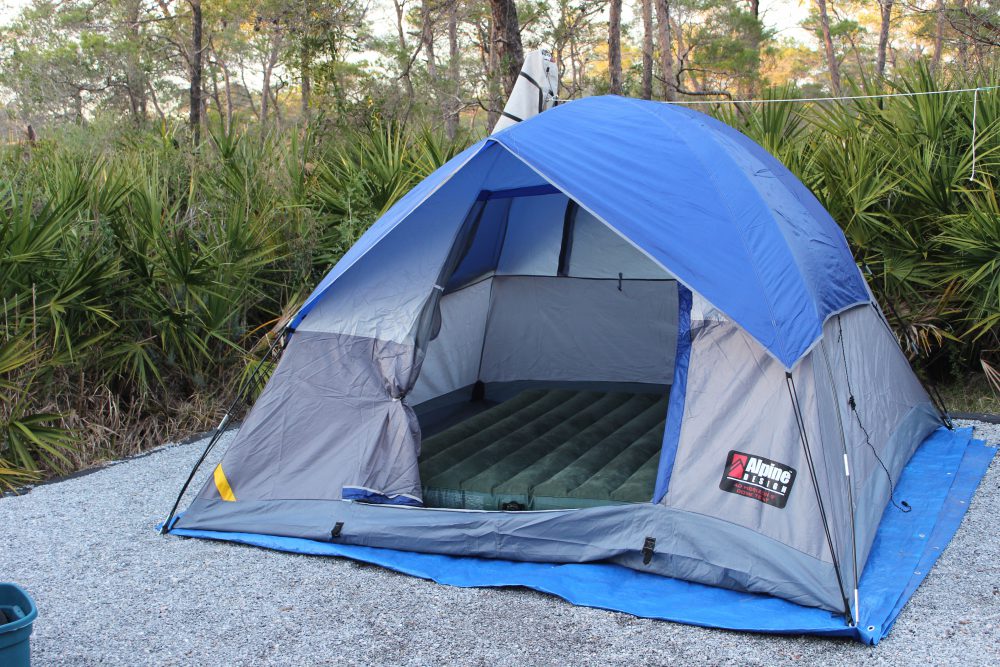
by Rick O'Connor | May 22, 2016
ALL PHOTOS: MOLLY O’CONNOR
Continuing our “ecotour” of the Florida Panhandle along the ICW, this month’s stop is in Walton County. Arguably one of the fastest growing counties in the state, South Walton has become a favorite with many. Relatively undeveloped (as compared to neighboring counties) Walton has an opportunity to develop smarter… and for a lot of it – they have.
Entering Walton County from the west you leave the concentrated tourism of Destin and enter Sandestin. Though still highly developed it slowly gives way to the Point Washington area and more open ground. Here you begin to encounter the famous Dune Lakes. There are no barrier islands along the coastline of Walton County. Instead the Gulf meets the peninsula separating it from Choctawhatchee Bay to the north. Along the Gulf there are magnificent dune fields and freshwater lakes that periodically are open to the Gulf. The lakes are unique in that they have freshwater habitats and tannic waters as well as saltmarsh and seawater when their “mouths” are open. This unique situation provides an ecosystem found in few places in our state. The now famous 30-A travels along these dune lakes across the entire of South Walton. Two state parks, a state forest, a bike trail, and small communities dot this famous trail.
Between 30-A and the Intracoastal Waterway to the north lies the Point Washington State Forest. Here lie acres of well managed pine forest. There are many trails that can be hiked, driven, or traversed by horseback. There are several trails here that are part of state forest’s Trailwalker Program. A major part of this well managed forest is prescribed burning.

This dune lake at Topsail State Park is one of many “stretched” across South Walton County.
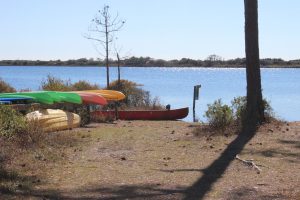
The state park provides kayaks for exploring the dune lake at Topsail. It can be reached by hiking or a tram they provide.
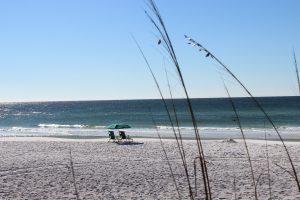
The beautiful beaches of south Walton.
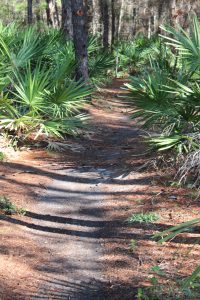
Here is one of the many state forest trails used by hikers and joggers.
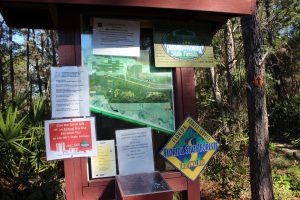
The Florida State Forest hiking trail system provides a lot of information about their trails that is very useful.
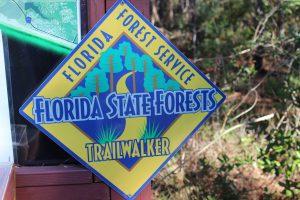
The Florida State Trailwalkers Program is a neat way to encourage locals to visit their “natural landscape”. You must hike 10 of the selected trails (on their website provided in this article). There is a log you can download and when you have logged your 10 hikes mail it in. You will receive a free patch indicating you are a “Florida Trailwalker”! This is a great way to explore your “natural Florida”.
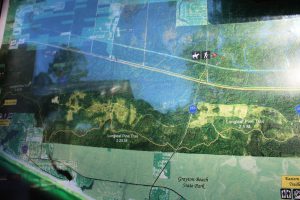
There are trails that cross Point Washington State Forest that can be driven, hiked, or even explored on horseback.
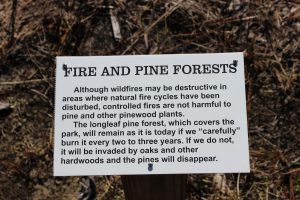
Signage educating the public about the benefits of prescribed burning.
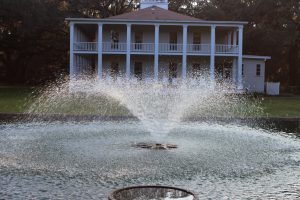
This is the renovated Wesley House at Eden Gardens State Park. The Wesley’s were in the timber industry.
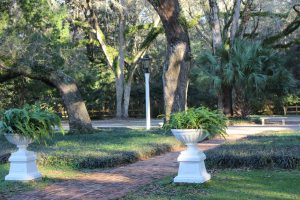
Eden Garden State Park is located north of Highway 98 in south Walton County. It borders the south side of the ICW near Choctawhatchee Bay and is a beautiful getaway.
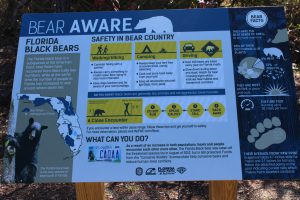
Partly due to successful bear management and partly due to the increase population of humans in the Florida panhandle, bear encounters are in the increase. This sign at Eden Garden State Park provides information on how to deal with an encounter.
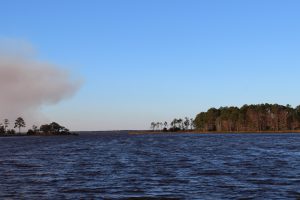
From Eden Garden State Park you can look across the bayou to the point where the ICW leaves Choctawhatchee Bay and enters a manmade canal locals refer to as “the ditch”. Notice the prescribed burn occurring across the bay.
PRESCRIBED BURNING
Now days many are aware of the forest management tool we call “prescribed burning”… but not all. For many people, fires are “wild” and the smoke they generate is an unwanted pain. Much of the southeast, particularly Florida, encounter thunderstorms with frequent lighting. These lighting strikes spark fires which burn across acres of forest. The frequency of the lighting storms – and fires – actually kept the understory below the pines cleared and so the fires typically burned low and slow. The result was an understory of grasses and wildflowers that supported a wide variety of species including deer and quail. When he traveled through the southeast in 1775, William Bartram described the longleaf forest as “open and monotonous – going on for miles”. And this was the case… you could literally see up to a mile across the landscape. But this “monotonous” landscape was misleading in that there were thousands of species found here – many feel one of the most biological diverse systems anywhere.
Today 90% of the longleaf has been logged and much of what remains is fire suppressed. For the reasons mentioned above, residents have resisted the natural burns and many species – gopher tortoises, quail, and indigo snakes to name three – have suffered as well. There is a move across the southeast to restore the old longleaf pine forest. These trees produce excellent timber – though it takes longer to grow than the loblolly and slash pine currently grown – and many are managing their property for quail and deer hunting. Yes… the smoke is a problem but the state forestry system plans their burns to reduce the impact it has on the local community as best they can. If you really want to see the benefits of a well-managed pine forest, take a hike through one – it truly is amazing.
by Ray Bodrey | May 13, 2016
The Annual Tupelo Honey Festival will be held on Saturday, May 21st from 9 AM – 4 PM at Lake Alice Park in Wewahitchka. It’s an exciting event, and your chance to take part in this local delicacy. Area honey producers will be on hand, selling their honey in a variety of sizes. There will also be food, art & crafts, and live music.
For decades, tupelo honey has been synonymous with Gulf county. The pollen from the tupelo gum tree (Nyssa ogeche), produces some of the finest honey in the world. The common name “tupelo” is derived from language of the Muscogee Nation, also known as the Creek Indian Nation. The meaning of the word is “swamp tree”, as this tree flourishes in areas of wet soils and seasonal flooding. Gulf county, especially in the Dead Lakes and Apalachicola river region, provides prime habitat for one of the largest tupelo forests on earth.
The tupelo pollination process kicks off during April. The tupelo bloom begins to form as a small bud. Within a few weeks, the bud explodes into a cluster of many nail or spike like attachments. At this point, honeybees begin to descend and capture the pollen.
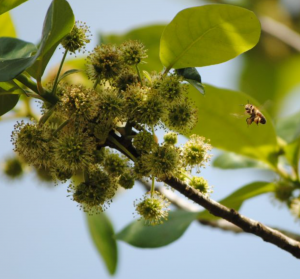
Figure 1. Honeybee visiting tupelo blossoms.
Credit. Gulf County Tourist Development Council.
The tupelo bloom season lasts from approximately mid-April to the end of May. This is an anxious time for beekeepers. Tupelo blooms are very temperamental and delicate in nature. For this short period, beekeepers hope for little wind or rain and no cold temperatures, as any of these factors can decimate tupelo honey production. Regardless of seasonal impacts, the demand for Gulf County’s tupelo honey never subsides.
A bonus to honey’s great taste, is the medicinal value. Honey has been used for medicinal purposes throughout time and cultures. Ancient Egyptians used honey in the embalming process, wound dressing and treatment for burns. Honey can be used as an antimicrobial agent. This is mostly due to low concentrations of hydrogen peroxide produced naturally from sugar compounds. Honey contains large amounts of sugars, approximately 97%. Most of the sugar content is glucose and fructose. Honey also contains smaller amounts of vitamins and minerals.
The color of honey is a factor when grading content. Generally, a darker honey will have a higher concentration of polyphenols. This means the honey is higher in antioxidants and anti-inflammatory properties. Exposure to area honey has been thought to help people who suffer from area specific seasonal allergies. However, there is no consensus among the scientific community to support the claim. Though there is research supporting honey as medicinal purposes, please consult with your physician before using as a medical treatment.
Enjoy tupelo honey and see you at the festival!
For more information on Gulf County Tupelo Honey, please visit:
http://www.tupelohoneyfestival.com/
https://www.visitgulf.com/tupelo-honey
Supporting information for this article can be found in the UF/IFAS EDIS publication “Health Benefits and Medicinal Value of Honey” by Sara Marshall, Liwei Gu and Keith R. Schneider: https://edis.ifas.ufl.edu/pdffiles/FS/FS26700.pdf
An Equal Opportunity Institution. UF/IFAS Extension, University of Florida, Institute of Food and Agricultural Sciences, Nick T. Place, Dean for UF/IFAS Extension. Single copies of UF/IFAS Extension publications (excluding 4-H and youth publications) are available free to Florida residents from county UF/IFAS Extension offices.





















